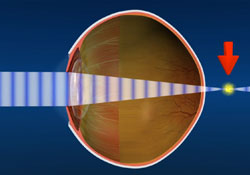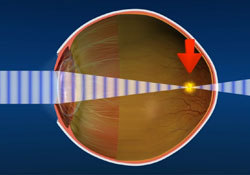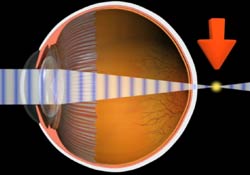We are happy to provide you with some basic information on several common vision conditions. Select from the following list or scroll to learn more about the symptoms and treatments for:
| Hyperopia | Myopia | Amblyopia |
| Presbyopia | Astigmatism | Computer Vision Syndrome |
Emmetropia
When light rays naturally focus directly on the retina of a relaxed eye, the eye is said to be emmetropic. Emmetropia means no corrective lenses are needed to see clearly at distance. It occurs because the optical power of the eye matches the length of the eye resulting in light focusing directly on the fovea for clear vision (as long as the retinal tissue is healthy).
The opposite of emmetropia is ametropia. With ametropia, the focal point of the eye is some distance in front of or behind the retina. The following vision conditions are types of ametropia.
Hyperopia
 Hyperopia is more commonly known as farsightedness. As the name suggests, people with farsightedness are able to focus on objects that are further away, but have difficulty focusing on objects which are very close. This is because the eyeball is shorter than normal and light comes to focus behind it. This forces the lens in their eye to focus in order to pull the focal point forward onto the retina for clear vision. Focusing is work, which can be tiring and lead to fatigue over the course of the day depending on the degree of hyperopia. About a fourth of the population is farsighted.
Hyperopia is more commonly known as farsightedness. As the name suggests, people with farsightedness are able to focus on objects that are further away, but have difficulty focusing on objects which are very close. This is because the eyeball is shorter than normal and light comes to focus behind it. This forces the lens in their eye to focus in order to pull the focal point forward onto the retina for clear vision. Focusing is work, which can be tiring and lead to fatigue over the course of the day depending on the degree of hyperopia. About a fourth of the population is farsighted.
A family history of hyperopia is a risk factor for developing hyperopia. Babies are often born with hyperopia but usually outgrow the condition as their eyes normalize meaning the focal point for the optics of the eye eventually matches the length of the eye.
Hyperopia can be corrected with eyeglasses or contact lenses. There are also new surgical procedures that can correct hyperopia.
Myopia
 Myopia is the medical term for what most people call nearsightedness. It is a condition in which a person can see objects clearly only when they are close; when objects are farther away it is difficult to focus on them. Myopia usually develops in early childhood, although it sometimes develops in early adulthood. Myopia puts people at higher risk for serious conditions such as retinal tear, retinal detachment, retinal holes and lattice degeneration.
Myopia is the medical term for what most people call nearsightedness. It is a condition in which a person can see objects clearly only when they are close; when objects are farther away it is difficult to focus on them. Myopia usually develops in early childhood, although it sometimes develops in early adulthood. Myopia puts people at higher risk for serious conditions such as retinal tear, retinal detachment, retinal holes and lattice degeneration.
Myopia is considered a genetic trait. If your parents are nearsighted, you are at greater risk of also being nearsighted. Another risk factor is “near work” – work involving fine detail or focusing on close objects.
Myopia can be corrected with eyeglasses or contact lenses. Sometimes myopia continues to gradually worsen throughout life, a condition known as myopic creep. Myopia can also be corrected by corneal refractive surgery such as PRK or LASIK.
Amblyopia
Amblyopia, commonly called lazy eye, occurs when one eye doesn’t develop clear vision because of misalignment (eye turn) or because it has a more significant refractive error (prescription) than the other. Regardless of the cause, the result is a less functional eye that never develops clear 20/20 vision. Amblyopia tends to be hereditary so if you have it you may pass it on to your children.
Symptoms
It’s hard to tell if your child has amblyopia unless you notice the child has an eye turn, which is a significant risk factor. It’s also impossible for a parent to determine if one eye has a more significant refractive error (prescription) than the other. The best way to tell if your child has a lazy eye is through a complete exam with an eye doctor. Bring your child in for an eye exam by age 3 but if you suspect a problem bring them in right away. Early diagnosis can prevent what could eventually become significantly diminished visual acuity and depth perception.
Treatment
Most of the time amblyopia cannot be entirely corrected. The vision in the amblyopic eye will always be a bit weaker than the other. However, with treatment, vision in the amblyopic eye can be improved to some extent. Treatment involves encouraging the weak eye to develop. This is done using eye patches and glasses. The strong eye may be patched to encourage the weak eye to develop. Most of the time the amblyopic eye will require glasses.
Presbyopia
 As a people get older, usually when they reach their mid 40s, a condition called presbyopia can develop. Presbyopia is the inability to focus on objects at near. One usually notices that it is harder to read or use the computer. Progressive lenses or reading glasses are a way to remedy this condition. These glasses supplement the focusing power we lose as we get older.
As a people get older, usually when they reach their mid 40s, a condition called presbyopia can develop. Presbyopia is the inability to focus on objects at near. One usually notices that it is harder to read or use the computer. Progressive lenses or reading glasses are a way to remedy this condition. These glasses supplement the focusing power we lose as we get older.
Presbyopia is a natural consequence of the aging process. There is no cure, though researchers are constantly looking for one. Even if someone has never had vision problems before, one can still develop presbyopia. It may seem to occur suddenly, but it actually occurs over a long period of time. Symptoms include having to hold things at arm’s length to see them clearly, eye strain, fatigue, and headaches from near work.
Astigmatism
 Sometimes the cornea is shaped irregularly resulting in two different focal points that don’t focus on the retina. This is known as astigmatism. For the cornea to bend light correctly, it should be spherically shaped, like a baseball or basketball. Astigmatic corneas are shaped more like a football which can cause blurry vision. The cause of astigmatism is unknown. Astigmatism is often associated with myopia or hyperopia and it usually is present from birth. It may be hereditary or it may be caused by disease, trauma or eye surgery. Mild astigmatism usually does not need to be corrected. Eyeglasses, contact lenses, or refractive surgery can correct moderate to high degrees of astigmatism.
Sometimes the cornea is shaped irregularly resulting in two different focal points that don’t focus on the retina. This is known as astigmatism. For the cornea to bend light correctly, it should be spherically shaped, like a baseball or basketball. Astigmatic corneas are shaped more like a football which can cause blurry vision. The cause of astigmatism is unknown. Astigmatism is often associated with myopia or hyperopia and it usually is present from birth. It may be hereditary or it may be caused by disease, trauma or eye surgery. Mild astigmatism usually does not need to be corrected. Eyeglasses, contact lenses, or refractive surgery can correct moderate to high degrees of astigmatism.
Computer Vision Syndrome
 Computer vision syndrome (CVS) affects three out of four computer users. It is a series of symptoms related to extended periods of computer usage. Though it is no cause for panic, measures can be taken to relieve symptoms of CVS.
Computer vision syndrome (CVS) affects three out of four computer users. It is a series of symptoms related to extended periods of computer usage. Though it is no cause for panic, measures can be taken to relieve symptoms of CVS.
Symptoms
CVS can appear as a variety of symptoms. Headaches, eye strain, neck and back aches, sensitivity to light, blurred vision, fluctuating vision, double vision, and red, dry or irritated eyes are all possible problems related to CVS.
Risk Factors
Any computer user can develop CVS. Your vision, your computer and the environment where you use your computer are all factors which can lead to CVS.





